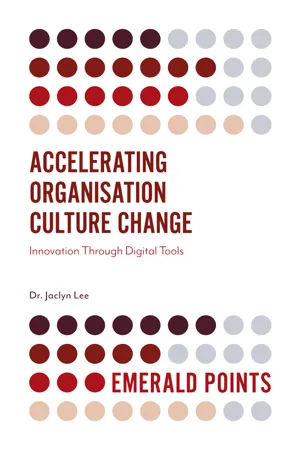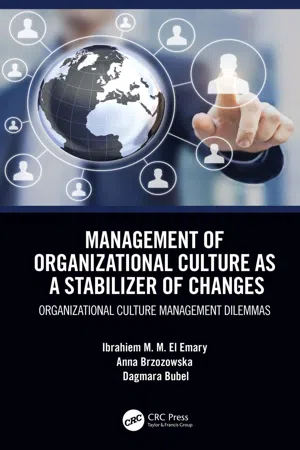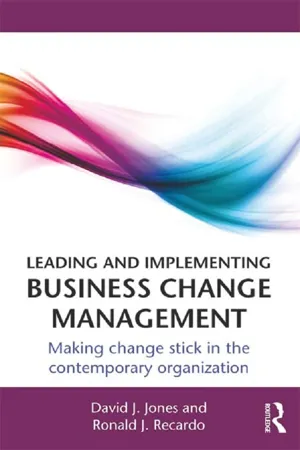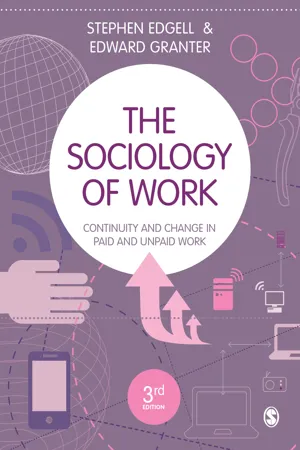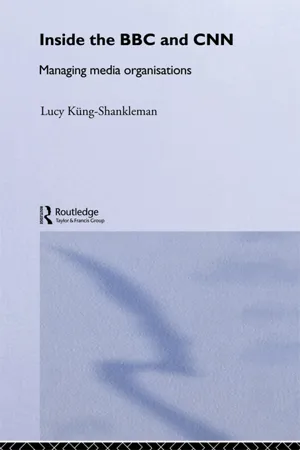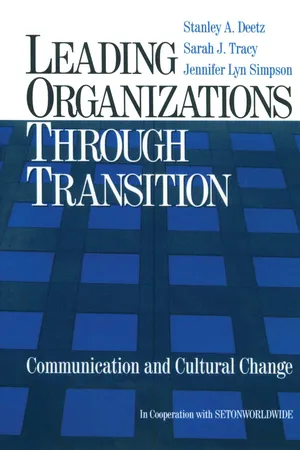Business
Managing Organisational Culture
Managing organizational culture involves shaping the values, beliefs, and behaviors that define a company's identity. This can be achieved through leadership, communication, and the reinforcement of desired cultural elements. By actively managing culture, organizations can align their values with their strategic goals and create a positive and productive work environment.
Written by Perlego with AI-assistance
Related key terms
Related key terms
1 of 4
Related key terms
1 of 3
11 Key excerpts on "Managing Organisational Culture"
- eBook - ePub
Accelerating Organisation Culture Change
Innovation Through Digital Tools
- Jaclyn Lee(Author)
- 2020(Publication Date)
- Emerald Publishing Limited(Publisher)
2
Organisational Culture and Change Management2.1 Definition of Organisational Culture
Cameron and Quinn (2011) defined organisational culture as, “…the taken-for-granted values, underlying assumptions, expectations, and definitions that characterize organizations and their members. It is an enduring slow-to-change core characteristic of organisations” (Cameron & Quinn, 2011).Edgar H. Schein, a well-known culture guru, defines organisational culture as “A pattern of basic assumptions that a given group has invented, discovered, or developed in learning to cope with its problems of external adaptation and internal integration, and that have worked well enough to be considered valid. It is therefore taught to new members as the correct way to perceive, think and feel in relation to those problems” (Schein, 2004).Culture is also very complex and not easy to crystallize. However, it is a critical part of the organisational glue that binds people together toward a common vision and goal. Fralinger and Olson (2011) state that a strong and well-defined culture helps to pave the way for stakeholders to align their actions toward achieving an organisation's vision and objectives. Satya Nadella, in his book, Hit Refresh (2017), shares that an organisational culture is not something that can simply unfreeze, change, and then refreeze in an ideal way. It takes deliberate work, and it takes some specific ideas about what the culture should become.In another definition, the concept of culture, as described by a very successful CEO of a large global company with whom I recently spoke to, is one in which culture and values are very much integrated. It is the reason customers trust a company and why employees feel attracted to and have a sense of belongingness. This is also what holds a community together. He shares that culture needs to be built over time and protected, as it is something that can be fragile and easily broken. - eBook - ePub
Management of Organizational Culture as a Stabilizer of Changes
Organizational Culture Management Dilemmas
- Ibrahiem M. M. El Emary, Anna Brzozowska, Dagmara Bubel(Authors)
- 2020(Publication Date)
- CRC Press(Publisher)
The author emphasized the second condition, namely, the necessity of inculcating and reinforcing new patterns in order to make a long-term deep change. The process of change in organizational culture management is long term and requires engaging all members of an organization. It is also necessary if a gap exists between the present and desirable situation. In the case of decision-making, if the changes that are introduced are not in line with the organizational culture, they may provoke resistance and aversion in employees, who may hinder their implementation. In the case of decision-making and the necessity of making deep changes at the level of the whole organization, it is necessary to manage organizational culture in a way that supports and facilitates decision-making. In order for changes to be implemented effectively, a few conditions have to be met (Kleingarn 2013, pp. 288–295):- Developing plans
- Good communication; developing an appropriate form of information distribution and continuous and systematic distribution of information
- Engaging the managerial staff
- Stabilizing the relationships among colleagues
- Personal responsibility, since for a change to be possible all members of an organization must understand their responsibilities; it is also necessary to make sure that everybody is fully informed
Organizational culture management has an impact on the effectiveness of an organization by influencing the productivity of its members, boosting motivation and engagement, controlling and verifying organizational behaviors and cooperating with other subsystems of an organization. In this context, culture management may lead to a radical change of culture or reinforcing of the existing culture. However, in order for change to be profound and lasting, and the new norms and values approved and accepted by the members of an organization, appropriate methods have to be applied. The following dimensions of organizational culture management can be distinguished (Gergs 2016, pp. 189–203):- Developing a vision and boosting engagement of the members of an organization; employees should identify with their organization, and a clear vision should help to achieve that
- Ensuring appropriate communication and education that should state the necessity of making changes and the benefits of the implementation of the changes both for the organization as a whole and for its individual members
- Creating systems and processes that facilitate the introduction of changes that support the implementation of a new culture
Hans Joachim Gergs (2016, pp. 189–203) presented the methods of shaping organizational culture, both directly and indirectly. The direct methods, on the level of an individual and group, include the following: - eBook - ePub
Managing Strategy
Your guide to getting it right
- Chartered Management Institute(Author)
- 2014(Publication Date)
- Profile Books(Publisher)
Understanding organisational cultureOrganisational culture is the way that things are done in an organisation, the unwritten rules that influence individual and group behaviour and attitudes. Organisational culture is defined by the organisation’s structure, the behaviour and attitudes of its employees, and the management and leadership style adopted by its managers. Organisational culture reflects the personality and character of the organisation, and is composed of the values, beliefs and basic assumptions that are shared by members of an organisation.An understanding of organisational culture is crucial for effective leadership. Leaders and managers will be better placed to implement strategy and achieve their goals if they understand the culture of their organisation. Strategies that are inconsistent with organisational culture are more likely to fail, while strategies that are in line with it are more likely to succeed. It is also important to understand the existing culture of an organisation before thinking about change.The workforce of an organisation swiftly comes to understand its particular culture. Culture is a concept that may be difficult to express plainly, but everyone knows it when they see it. For example, the culture of an informal software company may be quite different from that of a large financial corporation and different again from that of a hospital or a university.To gain an understanding of the culture of an organisation, the relationships between values, behaviour and unwritten rules must be examined. This checklist outlines the main steps and questions to ask to help gain this understanding. Some well-known methods used to classify organisational culture are also introduced.Organisations are human communities, peopled with individuals. Once managers develop an understanding of why people and their organisation behave as they do, they will be able to improve effectiveness, communication, organisation, control and, ultimately, results. - eBook - ePub
Leading and Implementing Business Change Management
Making Change Stick in the Contemporary Organization
- David J. Jones, Ronald J. Recardo(Authors)
- 2013(Publication Date)
- Routledge(Publisher)
Despite its recognized importance to business change, the concept of culture is not simple to grasp. Culture represents the essence of the organization. It is more easily sensed and expressed by outsiders to the organization than by its members who operate automatically within the culture. Our research indicates that no common definition of organizational culture exists across change management thought leaders. Definitions of culture often include an organization’s values, how members see themselves and how they interact with each other, how work gets done, the acceptable boundaries for behavior, and what gets rewarded or punished. We define culture as the cultural characteristics, values, and behaviors that are resident in the organization.What makes culture so powerful and gives it such lasting impact? Culture embodies shared assumptions that explicitly and implicitly guide how members of the organization behave in work situations. These assumptions would have been formed early in an organization’s history when its leaders and members successfully worked through challenges together. Organizational culture pioneer Edgar Schein describes the motivation for creating these shared assumptions as a form of survival and adaptation that becomes embedded in the organization. These shared assumptions then get passed down to new employees as the organization evolves. He formally defines culture as:A pattern of shared basic assumptions that the group learned as it solved its problems of external adaptation and internal integration, that has worked well enough to be considered valid, and, therefore, to be taught to new members as the correct way to perceive, think, and feel in relation to those problems.3These cultural assumptions provided the organization’s members with needed stability and predictability as they initially worked through the organization’s challenges. As the organization grows the formative culture remains largely intact. Old habits die hard. Even as the business landscape outside the organization and the needs of its customers change around them, the organization’s values, leadership style, ways of communicating, and other facets of culture often prevail. Throughout the organization’s history, though, significant events and changes will impact the culture. Organizational members will be forced to adapt to these impacts, causing some changes in the predominant culture while reinforcing others. - eBook - ePub
Rethinking Management
Radical Insights from the Complexity Sciences
- Chris Mowles(Author)
- 2016(Publication Date)
- Routledge(Publisher)
Many discussions of values in the literature link together values and the idea of culture change, as we began to explore in the previous chapter. The central proposition is that organisations need to adapt to a fast-changing environment so that they can be better suited to succeed, and that organisational culture usually stands in the way of this necessary change. ‘Culture’ is here taken to mean the individual behaviour that contributes to the habituated daily interaction between employees. The appeal to values in organisations is directly consonant with some of the other management methods used by managers, which I have been discussing in previous chapters. These methods draw on ideas derived from systems theories which conceive of organisations as idealised wholes. Individuals are understood to be parts of these wholes, and in turn, values are sub-systems of individuals which can be reconfigured and lined up in a slightly different way which is more fitting to the imagined end state. If behaviour is guided by values, it is thought, then influencing people’s values will bring about the required behaviour change, that is to say, the types of belief and behaviour that senior managers think is necessary for the organisation to adapt to a new environment.This is another example of what I have been writing about in previous chapters where attempting to shape the employee’s ‘lifeworld’, their hopes, desires and sense of identity, is considered to be the legitimate domain of management. In addition, the manufactured anxiety around the necessity of organisational change can develop in employees the need for feelings of safety which can result in their conforming to changes which are required of them. In reaction, some critical management theorists (du Gay, 2007 ; Casey, 1999 , Willmott, 1993 - eBook - ePub
The Sociology of Work
Continuity and Change in Paid and Unpaid Work
- Stephen Edgell, Edward Granter(Authors)
- 2019(Publication Date)
- SAGE Publications Ltd(Publisher)
multicultural. The concept of culture exists on many levels, however, and getting a fix on what culture means and defining it are difficult tasks. Paradoxically, this is for the same reason that the concept seems so familiar; it is an ‘inferiental concept’, ‘something that is perceived, something felt’ (Handy 1976: 185, cited in Kuh and Whitt 1988: 10). So to say that a definition of culture as ‘the way we do things around here’ (Demers 2008: 76) is intuitive should not be taken as a criticism; this is the model of culture that many carry with us. As we shall see, this basic definition is elaborated by those studying culture in the context of work organizations, most notably to include how ‘we’ (i.e. people at work) feel, think, negotiate our identities and understand working life. Culture at work is commonly discussed as ‘organizational culture’ or ‘corporate culture’, although once again this is elaborated to include ‘sub-cultures’ within organizations, for example.The managers of contemporary organizations, particularly those employing larger workforces, are likely to claim that their company, university, hospital and so on has a particular culture (of customer service, performance, innovation, etc.) that influences employee behaviour. This is a relatively recent phenomenon, and yet one which is now ubiquitous. This chapter will consider how this understanding of organizational culture rose to prominence and review the critical perspectives which tend to see it as primarily a method of controlling people at work. The chapter will conclude with a brief examination of the role of culture in so-called resistance and misbehaviour at work.Introducing organizational culture
Organizational culture is generally seen as associated with elements of the workplace that relate to the symbolic – ‘rituals, myths, stories and legends’ (Frost et al. 1985, cited in Alvesson 2016: 264) – and to study it is to be concerned with ‘the interpretation of events, ideas and experiences that are influenced and shaped by the groups within which they live’ (Alvesson 2016: 264). Symbolic elements are most often represented discursively through the use of an intentional vocabulary: ‘our people’ rather than ‘workers’; ‘difficult decisions’ in place of ‘firing people’; ‘business’ instead of ‘production’ (Alvesson 2016: 277) for example. They can also be seen in the visual and physical environment which we encounter at work, from uniforms to logos on staff computer screens to ‘inspirational’ posters (for a critical perspective, see Bertram 2007; and for a mainstream perspective, see Aulet 2014). These are sometimes understood as ‘artifacts’ (Schein 1984: 4). To understand all of these things as part of organizational culture is to assume that they are ‘the way they are’ for a reason. Clearly, some are partly external facing in that they seek to influence the way an organization is viewed by the public. Generally, studies of organizational culture focus more on the ‘internal facing’ aspects and how these are understood by the people who have to face them every working day. - eBook - ePub
Introduction to Human Resource Management
A Guide to HR in Practice
- Charles Leatherbarrow, Janet Fletcher(Authors)
- 2018(Publication Date)
- CIPD - Kogan Page(Publisher)
These seven characteristics: innovation and risk taking, attention to detail, outcome orientation, people orientation, team orientation, aggressiveness and stability, when taken together, define how employees perceive the organisation. Each characteristic may be more or less dominant in different organisations, so defining the perceived prevailing culture. Lorsch and Tierney (2002) suggest that the true nature of an organisation’s culture is what its members do when they are not being observed. Why study organisational culture? By studying an organisation’s culture, it enables HR practitioners, managers and consultants to understand why people in organisations behave as they do. Attempts can then be made to change an overtly negative culture to make it more conducive to the achievement of section, department and overall organisational objectives. Moorhead and Griffin (1992) consider that organisational culture probably exerts the greatest influence on individual behaviour when the culture is taken for granted. One of the major reasons that organisational culture is such a powerful influence on employees is that it is not explicit. Instead, it is an implicit { meaning it is not plainly expressed } part of the employees’ values and beliefs. According to Greenberg (2013, p370): ‘It would be reasonable to think of organisations as unique because of the various cultural forces that shaped them. Indeed, culture plays several important roles in organisations.’ Greenberg (ibid) suggests that culture: provides a sense of identity; generates commitment to an organisation; clarifies and reinforces standards of behaviour. Zhang and Iles (2017, cited in Rees and Smith, 2017) point out the difficulties of offering a silver-bullet approach { meaning – the best/most appropriate method } by suggesting the type of culture that should be adopted to best deliver corporate goals - eBook - ePub
Inside the BBC and CNN
Managing Media Organisations
- Lucy Küng-Shankleman(Author)
- 2012(Publication Date)
- Routledge(Publisher)
As its ‘latent power’ grew, so too did its perceived influence on strategic processes. Research by Kotter and Heskett (1992) concluded that it could have a significant impact on long-term economic performance. Firms with cultures that emphasised key constituency groups – customers, shareholders, employees – and leadership from all levels, outperformed by a large margin companies that did not display these characteristics. Indeed, culture became the starting place for strategy:strategy must be a natural expression of the potential latent in a culture. Because corporate cultures are unique, the products inspired by a culture can be original and incomparable to the offerings of competitors. Hence, a competitive strategy should begin with the culture of the organisation.(Hampden-Turner, 1990: 253)Schein's concept of culture
Culture is to the organisation what character is to the individual. (Schein, 1992: 196)Culture is normally imprecisely defined – typically as an emergent pattern of shared beliefs, norms and values, unique to the organisation concerned. In contrast, Schein5 offers a definition that is both comprehensive and precise, and therefore suitable as a basis for empirical research. For Schein, culture is:a pattern of shared basic assumptions that a group learned as it solved its problems of external adaptation and internal integration, that has worked well enough to be considered valid, and therefore is taught to new members of the group as the correct way to perceive, think and feel in relation to those problems.(Schein, ibid.: 12)Culture is essentially, therefore, nothing more than the accumulated learning shared by a set of members of an organisation. This learning has been acquired as the group deals with the challenges posed by the environment and by the organisation as it develops and matures. In the course of this problem-solving process a number of precepts emerge which repeatedly prove themselves effective. These represent a set of basic tacit assumptions about how the world is and ought to be, assumptions which determine perceptions, thoughts, feelings and, to some degree, overt behaviour. They come to function as heuristics, shortcuts to future problem-solving. New members learn these assumptions as part of their socialisation, and thus the culture is perpetuated (Schein, ibid.). - Tim Scott, Russell Mannion, Huw Davies, Martin Marshall(Authors)
- 2018(Publication Date)
- CRC Press(Publisher)
The models illustrate how organisational culture change can be understood in different ways. No conclusions can be drawn concerning which is the best model to apply. Collectively, the models indicate the complexity of organisational culture and organisational change. This level of difficulty is matched by the high level of unpredictability of success or failure of programmes of organisational culture change. It should be remembered that a basic function of organisational culture is to stabilise and establish a way of living. Resistance to change is therefore inherent to culture.Arguably no model could incorporate the complexity involved in actual culture change. However, organisational change is both necessary and increasingly frequent, with all of the attendant stresses and strains caused by instability and unpredictability. Perhaps the key challenge, therefore, is to try to understand the difficulties inherent in such change and the practical implications for participants in terms of the destabilising of their whole lives. The NHS is undergoing a number of change programmes simultaneously, which can be expected to impact on its culture in both expected and unexpected ways. The way in which these changes are designed and implemented (the process ) will probably affect the outcomes.How can organisational culture be assessed?
In this section we have reviewed a number of different perspectives on organisational culture, the role of organisational leadership and models of organisational culture change. The theoretical approaches covered raise a number of important points that are relevant to the assessment of organisational culture and culture change.- Organisational culture is a contested domain.
- A number of different theoretical approaches have been used.
- Organisational culture is a multiple phenomenon - a coalition of patterns of meaning forged by human groups and subcultures.
- A health service culture is produced not only by employees, but also by patients and the public.
- The relative power of subcultures and other influences in defining a dominant culture is an important issue.
- Leadership plays an important and complex role in culture and culture change.
Some reflections on organisational culture
We should not underestimate the level of difficulty involved in attempting to analyse any type of culture, or the pitfalls of adopting a polarised perspective. We should try to avoid two such pitfalls in particular, namely that of intellectually weak, woolly and lazy thinking (the bane of so much work on management topics) and, at the opposite pole, that of spurious operational terminology (which is so unhelpful in the social sciences). Given that the ‘object’ of our analysis is something as broad, complex and contested as organisational culture, it will be fruitful to adopt ‘a combination of loose and strict thinking- eBook - ePub
Leading Organizations through Transition
Communication and Cultural Change
- Stanley A. Deetz, Sarah J. Tracy, Jennifer Lyn Simpson(Authors)
- 1999(Publication Date)
- SAGE Publications, Inc(Publisher)
2Assessing and Changing Organizational Culture
OverviewAlthough most cultures are fairly deeply held and resistant to change, with careful attention cultures can and do change. This change can take many forms. A culture can be accentuated and its strength increased, it may be incrementally changed over rather lengthy periods of time, or it may be radically transformed usually over shorter periods of time. Each of these types of changes requires progressively more focused attention by organizational leaders or significant environmental changes—and often both—for transformational changes to occur.Like any change in business strategy, cultural change can, and should, only be attempted with a clear plan and clear objectives. Before initiating a change process the organizational leader should be clear as to what the character of the existing culture is and what functions the existing culture performs. This requires careful assessment. - eBook - ePub
Fast Cultural Change
The Role and Influence of Middle Management
- M. Nieswandt(Author)
- 2015(Publication Date)
- Palgrave Macmillan(Publisher)
Besides the roles of middle management, some research actually questions whether middle management today is still needed (Glietz 2011). Experience with middle managers who did not forward information satisfactorily caused top management within some organisations to build communication bypasses (Glietz 2011). In these circumstances, middle management is excluded from important processes, and one can assume that destructive behaviour of middle managers will continue to develop rather than be changed. In addition, one may ask whether middle managers are still of use when they only serve as operational organisers. Mantere’s (2008) enabling conditions steer a path so that middle managers become agents of change instead of obviating that change.In accord with much organisational culture, some authors argue for the need for culturally sensitive management (Kobi and Wüthrich 1986; Sackmann 2004; Simon 1990). They emphasise the need to develop a management (including middle management) that is aware of organisational culture, not only in times of obvious, and planned, cultural change. In my work as consultant I often experience organisations in which ‘culture’ and daily management seem to diverge. Organisational culture is the subject of occasionally offered training or campaigns. However, in combination with daily tasks or meetings, culture is not reflected. The reason for this seems to be a lack of cultural awareness and sensitivity. Therefore, the above-mentioned authors (Kobi and Wüthrich 1986; Sackmann 2004; Simon 1990) characterise a culturally aware and sensitive management based upon several aspects. First, management has to know about the meaning of organisational culture and its impacts. Without that knowledge, how could it act accordingly, particularly during change? Second, cultural sensitivity has to be developed. This means working out the relationship between a cultural mission statement, the values that are behind it and its manifold manifestations. Third, openness has to be created that at the same time appreciates the past and its positive aspects and is open-minded for the required adjustment of artefacts. In times of challenge and crisis (radical change of strategy and culture, for example), cultural assumptions have to be adjusted. Fourth, to realise this, management has to recognise in time the need to change the culture and must know about the meaning of assumptions and their effect on organisational life. The fifth aspect requires the ability to work with cultural dynamics consciously and adequately. Next, the sixth aspect is that management has to know about cultural networks and how to handle them. This last aspect requires both knowledge and ability concerning the configuration of social processes (Sackmann 2002).
Index pages curate the most relevant extracts from our library of academic textbooks. They’ve been created using an in-house natural language model (NLM), each adding context and meaning to key research topics.
Explore more topic indexes
Explore more topic indexes
1 of 6
Explore more topic indexes
1 of 4
